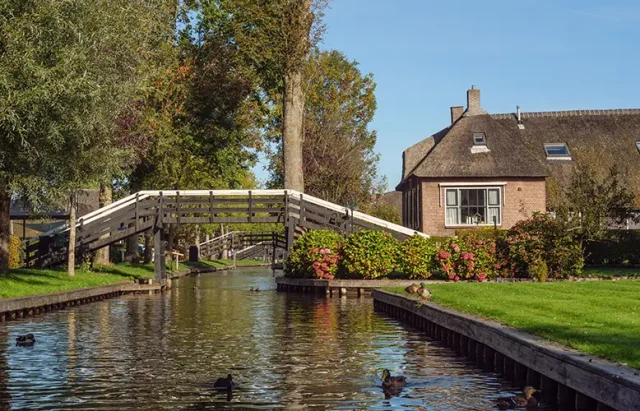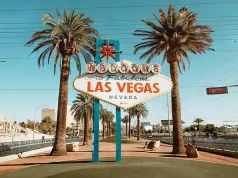
In the far north of the Netherlands, there is a village where streets are made of water. Giethoorn lies among canals and lakes, surrounded by flat fields and whispering reeds. Its houses stand on small islands linked by wooden bridges, each one curved and narrow like the back of a boat. The roofs are thatched, the gardens are green, and everything seems arranged with quiet care.
Arriving in Giethoorn feels like stepping out of time. There are no cars in the old village, only boats and bicycles. The air carries the soft sound of water moving under hulls and the creak of wooden planks as someone crosses a bridge. It is a place made for unhurried days, where distance is measured not in speed but in reflection.
A Village Built on Water
Giethoorn was founded in the Middle Ages by settlers who dug peat from the soil. As they worked, the pits filled with water, and over the centuries these small pools merged into lakes. The land that remained became a maze of narrow strips separated by canals. What began as necessity turned, slowly, into beauty.
The villagers learned to move by boat. They used long poles to push their punts through the shallow water, carrying hay, tools, or people from one bank to another. Today, the same rhythm continues. Visitors glide silently between houses, past willows and gardens full of hydrangeas, while locals still use small boats to travel between home and shop.
Everything in Giethoorn seems balanced between water and land, work and rest. The reflections are so clear that it is often hard to tell where the world ends and its mirror begins.
The Language of Silence
In the early morning, Giethoorn is almost completely still. Mist drifts over the canals, blurring the line between house and sky. Ducks move in slow circles, and the first sounds of life come from footsteps on wood and the low hum of a boat engine starting.
The quiet here is not emptiness but design. The absence of noise allows other things to emerge — the texture of the thatch, the smell of damp earth, the call of a bird hidden among reeds. Even when visitors fill the canals later in the day, the village retains its calm, as though the water itself absorbs the sound.
At night, when the lanterns light the bridges, the reflections return. The air cools, the windows glow, and everything slows to the rhythm of the ripples.
Between Canals and Fields
Beyond the old village, the landscape opens into the wide wetlands of De Weerribben-Wieden National Park. It is one of the largest freshwater areas in northern Europe, a mosaic of lakes, meadows, and reed beds. The water moves slowly here, connecting everything — farms, forests, and distant villages.
Paths and dikes lead away from the canals into open countryside. This is where the land reveals its scale. Cows graze near the edges of the water, herons stand still among the reeds, and the horizon stretches flat and endless. The wind carries the scent of grass and peat, and the sky feels enormous.
Many cycling holidays in Holland include this region, tracing quiet paths between Giethoorn and nearby towns like Blokzijl or Steenwijk. The rides are gentle, guided by the lines of the canals and the steady rhythm of the windmills. You pass small farms, wooden drawbridges, and boats moored under willow trees. Cycling here is not a sport but a way of listening to the landscape.
The Craft of Living
Giethoorn’s houses are small but precise. Each one sits neatly behind a hedge or fence, with a narrow strip of garden leading to the water. The care people take with their homes feels almost instinctive — a reflection of the Dutch habit of balance and order.
Many houses still carry traces of the past: brick chimneys built for peat fires, narrow windows to hold back the cold, and low doorways that open directly to the canal. The bridges, all wooden, are hand-painted each spring. Their white railings catch the light and stand out against the green and blue around them.
In summer, flowers spill over the paths, and the air hums with bees. In winter, when the water freezes, the canals turn into streets again. People skate from house to house, wrapped in scarves, laughing as they cross the ice. The village does not change; it simply shifts with the seasons.
Water as Memory
In Giethoorn, the water holds the memory of work and time. Every canal, every pond, every reflection tells the story of how people once shaped the land and then learned to live within its limits. The peat that built this village also built its character — resilient, patient, modest.
There is no single landmark that defines Giethoorn. Its beauty comes from repetition and restraint. The curve of a bridge, the pattern of ripples, the sound of a boat’s wake spreading along a wall — these small things create a sense of completeness.
The Dutch have always managed water through precision, and Giethoorn feels like the most personal expression of that mastery. Not an engineering feat, but a quiet agreement between people and nature.
The Light of Evening
As the day ends, the light in Giethoorn becomes soft and golden. The sun moves low over the fields, and the reflections in the canals turn to amber. People sit on small terraces by the water, their voices low, the air carrying the smell of bread and wood smoke.
The bridges cast long shadows across the water, and the last boats return slowly to their moorings. The stillness deepens, but it never feels empty. You can hear the small sounds that fill the space — the water against the hulls, the wings of ducks, the faint rustle of trees.
Night comes gently, without ceremony. The village seems to fold into itself, content in its own quiet rhythm.
A World Preserved by Stillness
Giethoorn endures because it has never rushed to modernize. It holds onto its form not out of nostalgia but because it fits the place perfectly. The canals still serve their purpose, the houses still face the water, and life still moves at a pace that allows for thought.
Visitors come to see its beauty, but what they often find instead is a kind of peace. The village is not an escape from the world but a reminder of what the world can be when shaped with care.
Giethoorn does not ask you to do anything. It only invites you to be still long enough to hear how water sounds when it becomes part of life.





